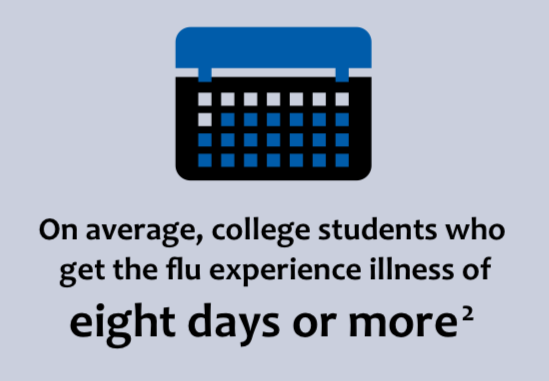
Time to get smart about flu outbreaks on campus
Your students may be the smartest, most responsible kids to ever grace a college campus. But guess what? Despite the deadly nature of flu, they likely fail when it comes to getting a flu shot each year. While annual vaccination is the best way to reduce the chance of coming down with our friend, influenza, flu vaccination rates on US college campuses are strikingly low — between eight and 39%. And in a campus setting, flu can spread incredibly quickly. What should a sick student do if they suspect flu? Both act fast and stay home! Isolating sick patients and getting them timely treatment are critical factors in treating flu. Unfortunately, students tend to do exactly the opposite of what they should:Act fast!
Anti-virals like Tamiflu (oseltamivir phosphate) can reduce flu severity and duration if given within 48 hours of flu onset. But too often, students try to push through! Ignoring first symptoms, they may wait too long to get treatment — all the while infecting their peers.Stay home!
The CDC says ““If you go to the emergency room and you are not sick with the flu, you may catch it from people who do have it.” So, when our sick student finally decides to head to a campus clinic — or worse, an urgent care or ER — that’s when they may actually catch and/or contribute to flu’s spread! It doesn’t have to be this way. The smart solution for managing flu across your student population is virtual care. Campuses can offer students an incredibly easy way to get diagnosed, get timely treatment, and reduce potentially contagious contact.Telehealth is a cost-effective, convenient way to cut flu cases, flu severity, and flu duration. Imagine our sick student — busy, under deadlines, filled with the optimism of youth, but not feeling so hot today. A quick telehealth visit is all it takes to give that student peace of mind, and faster, more effective treatment if they have the flu. Visits by laptop or phone are so easy, students are more likely to reach out in a timely manner. If a student does have flu, helpful prescriptions are filled faster to fully benefit the patient. If they do NOT, one more student is saved from contagious contact with peers who really do have the bug. Today, students who get flu end up sick for eight days or more on average — that’s way too many days of poor academic performance, missed activity, and infecting others. Sick students may not only infect their peers, but also faculty and clinic staff, leading to cancelled classes and further overburdening campus clinics. As flu sweeps through campus, worried parents can become frustrated with university management of student health. The good news? Virtual care is a natural fit for student lifestyles, making it easy to help students understand how to protect themselves, and how to behave if they suspect flu. Telehealth creates a valuable communications channel between campus health resources and students — one that can comfort parents, and even remind students to get that flu shot in the first place! The time to think about next flu season on campus is now. You have the power to simply and significantly change next year’s flu equation for your campus with telehealth. Talk to TimelyCare today, and take steps to a smarter way to manage flu this coming year — and every year.







